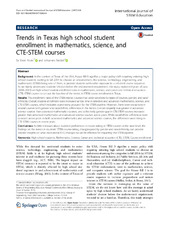| dc.creator | Yoon, So Yoon | |
| dc.creator | Strobel, Johannes | |
| dc.date.accessioned | 2017-06-30T22:42:57Z | |
| dc.date.available | 2017-06-30T22:42:57Z | |
| dc.date.issued | 2017-05 | |
| dc.identifier.citation | Yoon, S. Y., & Strobel, J. (2017). Trends in Texas high school students' enrollment in mathematics, science, and CTE-STEM courses. International Journal of STEM Education, 4, 9. doi: 10.1186/s40594-017-0063-6 | en |
| dc.identifier.uri | https://hdl.handle.net/1969.1/160526 | |
| dc.description.abstract | Background: In the context of Texas of the USA, House Bill 5 signifies a major policy shift requiring entering high school students starting in fall 2014 to choose an endorsement, like science, technology, engineering, and mathematics (STEM) being one of them, to provide students with earlier exposure to a coherent course sequence. As we barely understand students’ choices before the endorsement requirement, this study explored 6 years of data (2008–2013) on high school student enrollment rates in mathematics, science, and career and technical education (CTE)-STEM courses to set out the baseline of the trends in STEM course enrollment in Texas.
Results: The enrollment rates of the STEM-related courses had wide variations by types of courses, gender, and race/
ethnicity. Overall, student enrollment rates increased across time in selective and advanced mathematics, science, and CTE-STEM courses, which indicates a promising prospect for the STEM pipeline. However, there were exceptions in several courses with gender and racial/ethnic differences in the trends. Gender disparity was greater in advanced science courses than advanced mathematics courses, and collectively, gender gap in CTE-STEM courses increased greater than advanced mathematics and advanced science courses across years. While racial/ethnic differences were constant across years in both advanced mathematics and advanced science courses, the differences were rising in CTE-STEM courses in recent years.
Conclusions: As little is known about students’ preferences in course-taking in STEM courses at the state level, the findings on the trends in students’ STEM course-taking, disaggregated by gender and race/ethnicity, can provide needed insights on what institutional K-12 changes would be effective for impacting the STEM pipeline. | en |
| dc.description.sponsorship | Texas A&M University Open Access to Knowledge Fund (OAKFund) | en |
| dc.language.iso | en_US | |
| dc.publisher | International Journal of STEM Education | |
| dc.rights | Attribution-NonCommercial-NoDerivs 3.0 United States | en |
| dc.rights.uri | http://creativecommons.org/licenses/by-nc-nd/3.0/us/ | |
| dc.subject | High school students, Mathematics, Science, Career and technical education, STEM, Course enrollment | en |
| dc.title | Trends in Texas High School Student Enrollment in Mathematics, Science, and CTE-STEM Courses | en |
| dc.type | Article | en |
| local.department | Other | en |
| dc.identifier.doi | 10.1186/s40594-017-0063-6 | |



